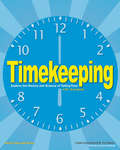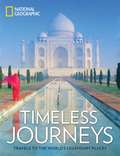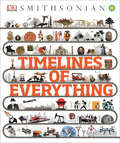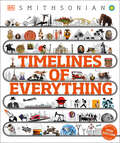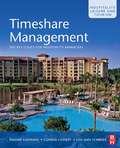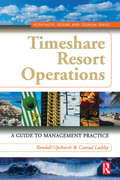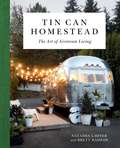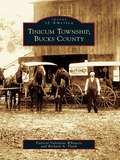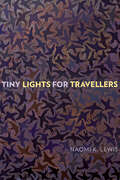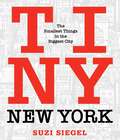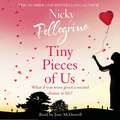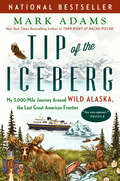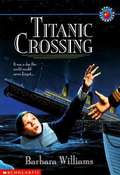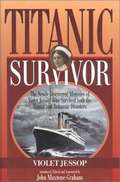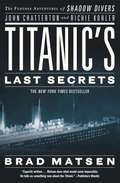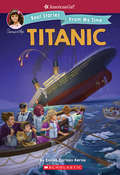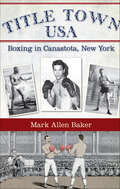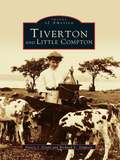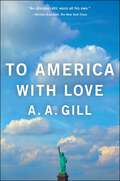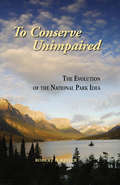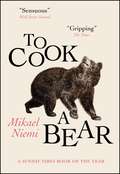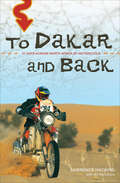- Table View
- List View
Timekeeping
by Sam Carbaugh W Eric Martin Linda FormichelliTimekeeping: Explore the History and Science of Telling Time travels through the past and into the future to explore how humans have measured the passage of time. From ancient civilization's earliest calendars and shadow clocks to GPS and the atomic clocks of today, kids will track the evolution of timekeeping devices, meet the inventors of calendars and clocks, and learn interesting facts and trivia. Hands-on projects and activities include making a shadow clock, using a protractor to create a sundial, measuring time using water, and creating your own calendar. Kids will understand how civilization's vague abilities to track days and months has transformed over the centuries into a sophisticated ability to keep time to the millionth of a second.
Timeless Journeys: Travels to the World's Legendary Places
by National Geographic Ford CochranFrom Machu Picchu to the Pyramids of Giza and beyond, this travel-lover's delight takes readers on a breathtaking visual journey to the world's most historic wonderlands. Pack your bags for an extraordinary adventure with National Geographic to more than 50 places that have captivated our imaginations for centuries. In this visually stunning volume, the world's leading authority on cultural travel and history showcases bucket-list-ready destinations on every continent, from Easter Island's haunting stone moai to Kyoto's breathtaking temples. Vintage photographs from the National Geographic archives tell the backstory of the discovery and earliest visitors to places like Carthage, Pompeii, Victoria Falls, and more, while showstopping contemporary photographs bring them to life in exquisite detail. Full-spread features highlight lesser-known hidden sites, such as Pompeii's better-preserved sister city Herculaneum and the less-visited Maya city El Mirador in Guatemala’s jungle, offer readers extraordinary opportunities to deepen their travel experience and discover places where the past can truly come to life. With practical travel tips to help readers get started planning their own legendary journey, this is the perfect gift to keep—or share.
Timelines of Everything (DK Children's Timelines)
by DKExplore 13 billion years of history in the comfort of your own home! Journey through time and discover how some of the world&’s greatest events unfolded.From the Big Bang all the way through to the digital age, this incredible visual encyclopedia for children shows you just about everything that has ever happened in history.Witness history come alive as you travel through more than 130 stunning timelines. Packed with fantastic photographs and illustrations, along with informative text and fun facts. The history book covers the rise and fall of empires to ground-breaking scientific breakthroughs and inventions that changed our lives. This educational book is an imaginative way of illustrating world history for children age 8 and over. Throughout the pages, your child will get to meet the most bloodthirsty pirates of all time and discover what happened during the storming of the Bastille. It&’s a fantastic book for young readers with a natural curiosity about history around the world.Find your place in the world and understand where you fit in. Whether you want to discover the history of cinema, fashion, aviation, or espionage. There is something for everyone in this glorious guide through global history!The History of Everything… Ever!This fascinating reference book tells the story of a diverse range of subjects throughout history in an easily digested graphic format! After your kids dive into this book, you'll never hear them use the words "history" and "boring" in the same sentence again.Take a trip back in time! This history book covers the following eras: • Prehistory: Before 3000 BCE • The Ancient World: 3000 BCE – 500 CE • The Medieval World: 500 – 1450 • The Age of Exploration: 1450 – 1750 • The Age of Revolution: 1750 – 1914 • The Modern World: After 1914
Timelines of Everything: From Woolly Mammoths to World Wars (DK Children's Timelines)
by DKExplore 13 billion years of history in the comfort of your own home! Journey through time and discover how some of the world&’s greatest events unfolded.From the Big Bang all the way through to the digital age, this incredible visual encyclopedia for children shows you just about everything that has ever happened in history.Witness history come alive as you travel through more than 130 stunning timelines. Packed with fantastic photographs and illustrations, along with informative text and fun facts. The history book covers the rise and fall of empires to ground-breaking scientific breakthroughs and inventions that changed our lives. This educational book is an imaginative way of illustrating world history for children age 8 and over. Throughout the pages, your child will get to meet the most bloodthirsty pirates of all time and discover what happened during the storming of the Bastille. It&’s a fantastic book for young readers with a natural curiosity about history around the world.Find your place in the world and understand where you fit in. Whether you want to discover the history of cinema, fashion, aviation, or espionage. There is something for everyone in this glorious guide through global history!The History of Everything… Ever!This fascinating reference book tells the story of a diverse range of subjects throughout history in an easily digested graphic format! After your kids dive into this book, you'll never hear them use the words "history" and "boring" in the same sentence again.Take a trip back in time! This history book covers the following eras: • Prehistory: Before 3000 BCE • The Ancient World: 3000 BCE – 500 CE • The Medieval World: 500 – 1450 • The Age of Exploration: 1450 – 1750 • The Age of Revolution: 1750 – 1914 • The Modern World: After 1914
Timeshare Management: The Key Issues for Hospitality Managers
by Conrad Lashley Tammie Kaufman Lisa SchreierVacation ownership is becoming a mainstream travel product. Continued growth based on number of units sold and an increasing number of international brands has placed this segment in a very strong position. As the market continues to grow there is an increasing demand for clear and engaging sources of information on the key issues and components of vacation ownership, from both hospitality management students and the public.This book updates hospitality students in this vacation sector, provides the key background information, explanation of the growth, the components to vacation ownership management and an overview of opportunities in vacation ownership management. Timeshare Management provides the understanding of the financing, marketing, sales, management, and human resource issues surrounding the subject - vital to any hospitality and tourism student.
Timeshare Resort Operations (Hospitality, Leisure, And Tourism Ser.)
by Conrad Lashley Randall UpchurchThis book provides a complete overview of timeshare development and operation models. The authors take a comprehensive look at the present and future of this growing segment of the hospitality industry, including specialized approaches to marketing, human resources, service quality, finance, legal considerations and professional ethics. Timeshare, or vacation ownership, is a relatively recent leisure phenomenon. It emerged in the late 1950s as a way to secure extra capital resources to fund property expansion. Shareholders had the right to use these properties on a regular basis. Although arrangements have grown in complexity and variation, the model allows for customers to buy rights to use a property for a fixed time period each year. Timeshare arrangements have experienced rapid international growth particularly in the last fifteen to twenty years and are now an important vacation arrangement. Most of the world's major hotel and resort developers now operate timeshare properties. Firms like Marriott, Hilton, Hyatt, Disney and Ramada have brought a new formality and legitimacy to timeshare development and operation.
Tin Can Homestead: The Art of Airstream Living
by Natasha LawyerDIY enthusiasts, tiny house-lovers, and van-lifers will find inspiration and step-by-step instructions in Tin Can Homestead, the ultimate resource for living small in your own Airstream paradise.The Airstream trailer is the ultimate symbol of vintage wanderlust-and the classic touring vehicle's resurgent popularity has dovetailed with the tiny house movement, resonating with design-minded individuals looking to live small. Tin Can Homestead, based on the popular Instagram of the same name, is the ultimate resource for these would-be DIY-ers, and the perfect coffee-table addition for anyone looking for streamlined, modern lifestyle inspiration.Part practical how-to, part lushly illustrated design inspiration, Tin Can Homestead follows the story of one couple as they build themselves a new life in an old Airstream. Through personal stories and down-and-dirty checklists, this book guides readers through all stages of creating their own Airstream homes-from buying a trailer to plumbing and electrical work. With a hip, bohemian aesthetic and a fresh authorial voice, the authors pair their DIY knowledge with lifestyle advice-including décor, design, and entertaining-and abundant illustrations, from in-process photographs to hand-drawn illustrations.
Tinicum Township, Bucks County
by Richard A. Plank Patricia Valentine WhitacreTinicum Township remained just beyond civilization's limits as Europeans settled on farmland in lower parts of Bucks County early in the 18th century. Inhabited by Native Americans, the land was not appealing to Europeans. Tinicum was slowly settled by the English, Scotch-Irish, and Germans until early in the 20th century, when Eastern Europeans arrived, followed by artists and writers seeking refuge from city life. The hilly, rocky, and sometimes swampy topography that discouraged early settlement has continued to limit development of the rural areas between the six villages and hamlets of the township, so that early folks returning today would recognize the landscape and many of the homesteads they established here. Through vintage photographs, Tinicum Township, Bucks County celebrates the area's rich history.
Tiny Games for Work
by Hide SeekDesigned to give the maximum amount of fun for the minimum amount of rule-reading, Tiny Games for Work will let you find the perfect game for whatever situation you're in. All you need is this book, and the stuff that's around you. (Friends optional) Games for sticky notes and coffee grinds, games for dealing with customers and even games for working from home. Whether you're feeling creative or competitive, silly or energetic, we've got you covered.Games Include:Last Man StandingA game of competitive standing-up in meetings for 2 or more players.Do you have any meetings coming up?Countless esoteric etiquette rules govern when to stand and sit down in meetings, but this game follows one simple rule: you sit, you lose. Before your meeting, agree on who'll be playing. When you go in for the meeting, the last player to sit down wins. At the end of the meeting, why not play Last Man Sitting? You can figure out the rules. Next time, why not stand on one leg only?2002 Berlin Thunder SeasonA game for any number of bold e-mailers unafraid of creative metaphor. Do you have a computer with Internet access and work e-mails to send?Subject to the whims of Wikipedia's 'Random article' feature, you'll need to slip some unusual words or phrases into work e-mails. Go to Wikipedia and click on 'Random article'. Note and copy the full title of your fascinating factually-accurate [citation needed] article. You must now subtly slip this full title somewhere into the next work e-mail you send.Repeat until satisfied, or until questioned about your references to obscure byelaws and pop songs. If you want to keep score, count how many you can fit into an e-mail...Don't Draw the Short StrawA game for an uneven number of players. Do you have pens and paper, and an odd number of players?In this game, you'll be drawing straws. On paper. With pens or pencils. Draw the longest or the shortest straw and you're out - the happy medium straw is what it's all about.Give everyone a piece of paper and a pen. Now, everyone - secretly draw a straw. You want your straw to be the medium-sized straw. Has everyone finished? Amazing.REVEAL YOUR STRAWS! The people who drew the LONGEST and the SHORTEST straw are both eliminated. Now, repeat until only one player remains - our winner! All the drawings of straws are yours - a glorious prize!
Tiny Lights for Travellers (Wayfarer)
by Naomi K. LewisGovernor General’s Award Finalist: A “wry, moving” memoir of a woman retracing her grandfather’s escape from Amsterdam during the Holocaust (Alison Pick, Booker-nominated author of Between Gods).Why couldn’t I occupy the world as those model-looking women did, with their flowing hair, pulling their tiny bright suitcases as if to say, I just arrived from elsewhere, and I already belong here, and this sidewalk belongs to me?When her marriage suddenly ends, and a diary documenting her beloved Opa’s escape from the Nazi-occupied Netherlands in the summer of 1942 is discovered, Naomi Lewis decides to retrace his route to freedom. Travelling alone from Amsterdam to Lyon, she discovers family secrets and her own narrative as a second-generation Jewish Canadian. With vulnerability, humour, and wisdom, Lewis’s memoir of her journey, interspersed with excerpts from her grandfather’s diary, asks tough questions about her identity as a secular Jew, the accuracy of family stories, and the impact of the Holocaust on subsequent generations.
Tiny New York: The Smallest Things in the Biggest City
by Suzi SiegelBecause in a giant city, sometimes the smallest things get overlooked.Tiny New York peeks into the city&’s nooks and crannies to find the little things that tell the real New York story. Because in New York, Tiny isn&’t cute. It&’s tough. Tiny doesn&’t wait for handouts. It hustles. Tiny isn&’t insignificant. It&’s precise. Tiny isn&’t a jack-of-all-trades. It&’s the master of one.There are plenty of books about New York City. But there has never been a book about the smallest things in the biggest city.
Tiny Pieces of Us: The new emotional and heartwarming page-turner you need to read in 2020!
by Nicky Pellegrino'Heartrending and compelling' JOJO MOYES on Recipe for LifeMy heart is less than 1% of my body, it weighs hardly anything; it is only a tiny piece of me, yet it is the part everyone finds most interesting.Vivi Palmer knows what it's like to live life carefully. Born with a heart defect, she was given a second chance after a transplant, but has never quite dared to make the most of it. Until she comes face-to-face with her donor's mother, Grace, who wants something in return for Vivi's second-hand heart: her help to find all the other people who have tiny pieces of her son.Reluctantly drawn into Grace's mission, Vivi's journalist training takes over as one by one she tracks down a small group of strangers. As their lives intertwine Vivi finds herself with a new kind of family, and by finding out more about all the pieces that make up the many parts of her, Vivi might just discover a whole new world waiting for her...Readers are loving Tiny Pieces of Us:'Warning! You will need tissues. Absolutely beautiful''Emotional and thought-provoking''Couldn't put it down!''Made me laugh, made me cry''Full of sensitivity, warmth and love'
Tiny Pieces of Us: The new emotional and heartwarming page-turner you need to read in 2020!
by Nicky Pellegrino'Heartrending and compelling' JOJO MOYES on Recipe for LifeMy heart is less than 1% of my body, it weighs hardly anything; it is only a tiny piece of me, yet it is the part everyone finds most interesting.Vivi Palmer knows what it's like to live life carefully. Born with a heart defect, she was given a second chance after a transplant, but has never quite dared to make the most of it. Until she comes face-to-face with her donor's mother, Grace, who wants something in return for Vivi's second-hand heart: her help to find all the other people who have tiny pieces of her son.Reluctantly drawn into Grace's mission, Vivi's journalist training takes over as one by one she tracks down a small group of strangers. As their lives intertwine Vivi finds herself with a new kind of family, and by finding out more about all the pieces that make up the many parts of her, Vivi might just discover a whole new world waiting for her...Readers are loving Tiny Pieces of Us:'Warning! You will need tissues. Absolutely beautiful''Emotional and thought-provoking''Couldn't put it down!''Made me laugh, made me cry''Full of sensitivity, warmth and love'
Tiny Pieces of Us: The new emotional and heartwarming page-turner you need to read in 2020!
by Nicky Pellegrino'Heartrending and compelling' JOJO MOYES on Recipe for LifeMy heart is less than 1% of my body, it weighs hardly anything; it is only a tiny piece of me, yet it is the part everyone finds most interesting.Vivi Palmer knows what it's like to live life carefully. Born with a heart defect, she was given a second chance after a transplant, but has never quite dared to make the most of it. Until she comes face-to-face with her donor's mother, Grace, who wants something in return for Vivi's second-hand heart: her help to find all the other people who have tiny pieces of her son.Reluctantly drawn into Grace's mission, Vivi's journalist training takes over as one by one she tracks down a small group of strangers. As their lives intertwine Vivi finds herself with a new kind of family, and by finding out more about all the pieces that make up the many parts of her, Vivi might just discover a whole new world waiting for her...Readers are loving Tiny Pieces of Us:'Warning! You will need tissues. Absolutely beautiful''Emotional and thought-provoking''Couldn't put it down!''Made me laugh, made me cry''Full of sensitivity, warmth and love'
Tip of the Iceberg: My 3,000-Mile Journey Around Wild Alaska, the Last Great American Frontier
by Mark AdamsFrom the acclaimed, bestselling author of Turn Right at Machu Picchu, a fascinating and funny journey into Alaska, America's last frontier, retracing the historic 1899 Harriman Expedition.In 1899, railroad magnate Edward H. Harriman organized a most unusual summer voyage to the wilds of Alaska: He converted a steamship into a luxury "floating university," populated by some of America's best and brightest scientists and writers, including the anti-capitalist eco-prophet John Muir. Those aboard encountered a land of immeasurable beauty and impending environmental calamity. More than a hundred years later, Alaska is still America's most sublime wilderness, both the lure that draws a million tourists annually on Inside Passage cruises and a natural resources larder waiting to be raided. As ever, it remains a magnet for weirdos and dreamers.Armed with Dramamine and an industrial-strength mosquito net, Mark Adams sets out to retrace the 1899 expedition. Using the state's intricate public ferry system, the Alaska Marine Highway System, Adams travels three thousand miles, following the George W. Elder's itinerary north through Wrangell, Juneau, and Glacier Bay, then continuing west into the colder and stranger regions of the Aleutians and the Arctic Circle. Along the way, he encounters dozens of unusual characters (and a couple of very hungry bears) and investigates how lessons learned in 1899 might relate to Alaska's current struggles in adapting to climate change.
Titanic Crossing
by Barbara WilliamsWhen the "Titanic" hits an iceberg during his voyage to America, young Albert is faced with grown-up decisions about life and death, in this "entertaining blend of fact and fiction" ("School Library Journal") concerning one of the most dramatic tragedies in history.
Titanic Survivor: The Newly Discovered Memoirs of Violet Jessop Who Survived Both the Titanic and Britannic Disasters
by Violet Jessop"Jessop has added a fresh, indispensable chapter to the legend of the Titanic that buffs & historians will find invaluable." Publishers Weekly "Many books on the subject are being published, but few can match this survivor's firsthand account in imparting a sense of immediacy." ALA Booklist "Jessop writes with an easy & enviable felicity.... The horror of the foundering Titanic... comes at the reader full force, as does the sinking of the hospital ship Britannic." Kirkus Reviews "I do not welcome ever more books on the Titanic, but the memoirs of a stewardess on board about that ship & the era, about her life & work... make a human story & historical vignette that needs no Titanic hype. But if that makes more people read it, so much the better, for through her own accomplished writing & Maxtone-Graham's perceptive annotations, one grows to love Violet Jessop." Lloyds List
Titanic's Last Secrets: The Further Adventures of Shadow Divers John Chatterton and Richie Kohler
by Brad MatsenAfter rewriting history with their discovery of a Nazi U-boat off the coast of New Jersey, legendary divers John Chatterton and Richie Kohler decided to investigate the great enduring mystery of history's most notorious shipwreck: Why did Titanic sink as quickly as it did?To answer the question, Chatterton and Kohler assemble a team of experts to explore Titanic, study its engineering, and dive to the wreck of its sister ship, Brittanic, where Titanic's last secrets may be revealed.Titanic's Last Secrets is a rollercoaster ride through the shipbuilding history, the transatlantic luxury liner business, and shipwreck forensics. Chatterton and Kohler weave their way through a labyrinth of clues to discover that Titanic was not the strong, heroic ship the world thought she was and that the men who built her covered up her flaws when disaster struck. If Titanic had remained afloat for just two hours longer than she did, more than two thousand people would have lived instead of died, and the myth of the great ship would be one of rescue instead of tragedy. Titanic's Last Secrets is the never-before-told story of the Ship of Dreams, a contemporary adventure that solves a historical mystery.
Titanic: Real Stories From My Time) (American Girl: Real Stories From My Time)
by Emma Carlson BerneDiscover the stories of the real people and events that shaped American history in the Real Stories From My Time series. Perfect for book reports with full-page illustrations throughout, these nonfiction chapter books also include historical photos, maps, a timeline, a glossary, and a bibliography at the back. Plus, in each book, an American Girl historical character shares a bit of her own fictional story. Titanic includes real life stories of the passengers who were aboard the supposedly unsinkable ship-from everyday life on board to the night of the infamous iceberg collision. American Girl Samantha Parkington shares her own story of traveling across the ocean as a first class passenger on a steamship in the early 1900s.
Title Town USA: Boxing in Canastota, New York
by Mark Allen BakerCanastota, New York, at the epicenter of Upstate New York's rich boxing heritage, is home to the International Boxing Hall of Fame. Having produced some of boxing's most prominent pugilists, including Carmen Basilio and Billy Backus, the area has also hosted many legendary fighters, including Jack Britton, Harry Greb, Sam Langford and Tommy Ryan. Many boxing dreams have come true here through title fights and epic ring rivalries. Author Mark Allen Baker tells the story of those "thunder gods of the ring" and the fights that made them famous, finally settling the score: Canastota is "Title Town, USA."
Tiverton and Little Compton: Historic Tales Of The Outer Plantations (Images of America #Vol. Ii)
by Richard V. Simpson Nancy J. DevinWith Tiverton and Little Compton, authors Nancy Jensen Devin and Richard V. Simpson invite you to travel historic roads, to explore late-nineteenth-century life in town, on the farm, on the sea, and at leisure. The reader will delight in sweeping views of the Sakonnet River and the Portsmouth shore from Fort Barton, and ride in a one-horse carriage down Main Road to Little Compton and the industrious fishing village at Sakonnet Point. A series of views from the Portsmouth Hummock offers a spectacular perspective of the Tiverton shore, where breakers crash majestically along the rocky coast. This narrow strip on Rhode Island's eastern flank forms one of the most peaceful, beautiful, and remote corners of the state. Readers will also observe the legacy and traditions of the Wampanoag Indians who settled this land centuries before the Puritans from Plymouth Colony.
To America with Love
by A.A. GillA celebrated British provocateur and Vanity Fair columnist serves up an “immensely entertaining book inspired by his love and knowledge of America” (Sunday Times, London).IN TO AMERICA WITH LOVE, celebrated British provocateur and Vanity Fair columnist A. A. Gill traverses the Atlantic to become the freshest chronicler of American identity in recent memory. With a fiery temper, a sharp-tongued wit, and an insatiable curiosity to figure out what makes more than 300 million of the world’s population tick, Gill traces the history and logic of our nation’s habits, collecting wild stories and startling facts along the way. From Colorado, where he meets a local vegetation expert and learns which flowers were in Pocahontas’s nuptial bouquet, to Kentucky, where he visits the Creationist Museum and drinks moonshine with a hog farmer, and to Harlem, where he misses a turn and stumbles into the wrong barbershop for a once-in-a-lifetime haircut, Gill embarks on a tour of not only the nation’s landscape but also its psyche, playing adventurer, philosopher, statistician, and raconteur all at once. In inimitable fashion he explains why pressing a button in a Manhattan elevator means entering a social contract of American etiquette and inverting conventional hierarchies of space; why browsing through Playboy centerfolds becomes the perfect litmus test for a generation’s political views; and how Hollywood is the metaphysical marketplace for movies, the place where Americans are sold on American romance and taught how to dream the American dream. Weaving together a tapestry of historical erudition and outrageous anecdotes, Gill ultimately captures the scope and spirit of a nation that started off as a conceptual experiment and became a political, scientific, and cultural fortress. This humorous and revelatory book shows us why we are who we are by transforming ordinary experiences into extraordinary lessons and promising to never let us look in the mirror the same way again.
To Conserve Unimpaired
by Robert B. KeiterWhen the national park system was first established in 1916, the goal "to conserve unimpaired" seemed straightforward. But Robert Keiter argues that parks have always served a variety of competing purposes, from wildlife protection and scientific discovery to tourism and commercial development. In this trenchant analysis, he explains how parks must be managed more effectively to meet increasing demands in the face of climate, environmental, and demographic changes. Taking a topical approach, Keiter traces the history of the national park idea from its inception to its uncertain future. Thematic chapters explore our changing conceptions of the parks as wilderness sanctuaries, playgrounds, educational facilities, and more. He also examines key controversies that have shaped the parks and our perception of them. Ultimately, Keiter demonstrates that parks cannot be treated as special islands, but must be managed as the critical cores of larger ecosystems. Only when the National Park Service works with surrounding areas can the parks meet critical habitat, large-scale connectivity, clean air and water needs, and also provide sanctuaries where people can experience nature. Today's mandate must remain to conserve unimpaired--but Keiter shows how the national park idea can and must go much farther. Professionals, students, and scholars with an interest in environmental history, national parks, and federal land management, as well as scientists and managers working on adaptation to climate change should find the book useful and inspiring.
To Cook a Bear: A Novel
by Mikael Niemi"So much to relish here . . . the plot is gripping, there's a beautifully handled thread on reading and writing, and the writing is just lovely!" DIANE SETTERFIELD, author of Once Upon A River"The year's most memorable narrator . . . An unusual and intriguing crime story" SUNDAY TIMES BOOKS OF THE YEAR"Niemi succeeds in constructing a story that works as a murder mystery and as a compelling study of a dangerously inward-looking community" SUNDAY TIMES"A riveting, psychologically astute mystery . . . It is not to be missed" BOOKLIST"An original and gripping crime story" THE TIMES**NOW SHORTLISTED FOR THE CWA INTERNATIONAL DAGGER**It is 1852, and in Sweden's far north, deep in the Arctic Circle, charismatic preacher and Revivalist Lars Levi Læstadius impassions a poverty-stricken congregation with visions of salvation. But local leaders have reason to resist a shift to temperance over alcohol.Jussi, the young Sami boy Læstadius has rescued from destitution and abuse, becomes the preacher's faithful disciple on long botanical treks to explore the flora and fauna. Læstadius also teaches him to read and write - and to love and fear God. When a milkmaid goes missing deep in the forest, the locals suspect a predatory bear is at large. A second girl is attacked, and the sheriff is quick to offer a reward for the bear's capture. Using early forensics and daguerreotype, Læstadius and Jussi find clues that point to a far worse killer on the loose, even as they are unaware of the evil closing in around them. To Cook a Bear explores how communities turn inwards, how superstition can turn to violence, and how the power of language can be transformative in a richly fascinating mystery."Superb suspense . . . Simply a great literary experience!" V.G. (Sweden) "A masterpiece of narrative" La Vanguardia (Spain)"A philosophical novel, a crime novel, a historical novel and a coming-of-age story complement one another" La Stampa (Italy)"One is transported into a strange time and a fascinating world that is both beautiful and brutal" Politiken (Denmark)"Formidable delivery . . . Unlike anything else you have read . . . An incredible novel" AdresseavisenTranslated from the Swedish by Deborah Bragan-Turner
To Dakar and Back: 21 Days Across North Africa by Motorcycle
by Lawrence HackingIn this adventure motorsports memoir, the first Canadian motorcycle racer to complete the infamous Paris-Dakar Rally recounts his incredible journey. The Paris-Dakar Rally is is without question the most arduous and notorious off-road motorsports event on the planet. Since its inception in 1979, it has attracted more than three thousand adventurers from all walks of life. The men and women who have taken up the &“Dakar challenge&” have at least one thing in common: a desire to measure themselves against the desolate sands of the Sahara. In 2001, Canadian adventure racer Lawrence Hacking entered what would be the last rally on the iconic route from Paris to Dakar. In To Dakar and Back, Hacking, in collaboration with motorsport journalist Wil De Clercq, recounts the three weeks of blood, sweat, and tears that took him on that ten thousand kilometer journey in the heat of competition from the glitzy streets of the French capital through the hinterland of North Western Africa and the triumph of self-realization.
